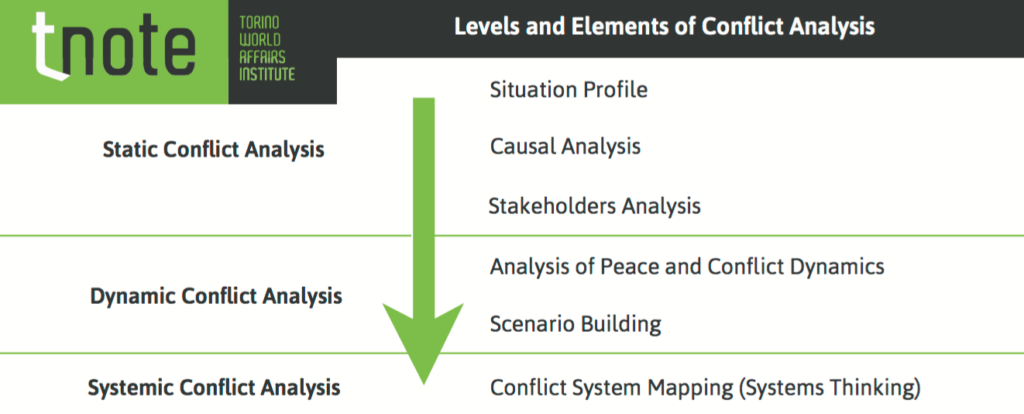
On June 22nd 2016, the United Nations System Staff College (UNSSC) launched its first Conflict Analysis Handbook with the aim of supporting practitioners working in contexts of deteriorating security, impending crisis, and violent conflict. A few days earlier, on June 8th, the Institute for Economics and Peace (IEP) released its latest Global Peace Index, outlining current trends in conflict and peace worldwide. Besides the timing, what these two documents have in common is the recognition that both violent conflict and positive peace are complex social phenomena endowed with system-like properties. To be better understood, and to eventually support the construction of peaceful societies, these phenomena need to be analysed as such.
Understanding the nature of violent conflicts is a long-standing quest that has always attracted scholars and practitioners. However, conflict analysis as a form of applied qualitative research for the study of the profile, causes, stakeholders, and dynamics of conflicts only emerged in the mid-1990s. It evolved thereafter, driven by advancements made in academic research on conflicts, the collection of field experiences, and the observation of tangible changes occurring internationally.
Yet, in spite of all the great strides made, it appears as if contemporary approaches to conflict analysis still possess limited tools to fully reflect the complexity of specific conflicts examined. What is more, these often fail to draw a complete picture of the situation at hand, making any issue unsolvable to the eye of external observers.
Like any analytical exercise, conflict analysis entails a process of abstraction, deduction, and simplification of reality. The success of this process, however, depends not only on the specific framework that is used, but also on the way in which it is used. For instance, in addition to the psychological and emotional aspects that need to be taken into account when dealing with violent conflict, different backgrounds, underlying assumptions, personal mind sets, and biases are other lenses through which people make sense of the world and, ultimately, analyse conflicts.
Groups conducting conflict analyses may employ similar frameworks and tools within their research. Yet, the results of their analyses may still diverge, depending on what part of the conflict is the one to which each of them relates the most. This fact clearly leads to analytical fallacies, also resulting in the adoption of vastly different approaches toward acting upon the conflict itself. Accordingly, a fragmented analysis may lead to the formulation of inconsistent policies that only seldom respond to the variations demanded by the situation on the ground.
At the other end of the analytical spectrum is “systems thinking”: an analytical framework which assumes that in order to comprehend complex phenomena, it is necessary to understand them as “systems” where various elements interact in non-linear ways. This way, any single factor in the system is conceptualized as being both cause and effect of at least one other factor. The complete separation between the individual parts of these systems is therefore conceived as not only misleading, but potentially counterproductive, as it constrains analyses within a partial and static understanding of real situations. Instead, “systems thinking” calls for the study of patterns of interaction, interconnectedness, and interdependence, among different peace and conflict factors. To account for this, applying “systems thinking” to conflict analysis offers a more comprehensive and nuanced view of causal relationships interwoven in social systems which create processes that stabilise, feed into, or diminish the impact of certain behaviours, such as violence and conflict.
The UNSSC Conflict Analysis Handbook and the 2016 Global Peace Index seem to move in this direction, attempting to build a new analytical mindset for a reorientation of the general approach to conflict analysis. Both documents, indeed, introduce “systems thinking” as a new framework for understanding factors that support peace and enrich existing approaches to conflict analysis and peace assessments with sharper insights.
Early applications of “systems thinking” into conflict analysis demonstrate that the attention paid to interactions is perhaps the greatest contribution of systemic conflict analysis to the realm of conflict transformation. By looking at interrelationships rather than single elements, systemic conflict analysis brings about a new way of conceptualising conflicts – one that helps moving beyond some of the major shortcomings of more traditional frameworks.
First, it can make assessments more sophisticated and dynamic, challenging over-simplification. Second, it offers a way to prioritise key factors and dynamics, which is crucial to identify leverage points where efforts could be targeted to achieve positive social change. Third, systemic conflict analysis can be used to anticipate the emergence of unintended consequences, and to understand why certain activities – such as humanitarian assistance, development cooperation, or peacebuilding – struggle to achieve their expected results. Eventually, this can help identify synergies, deficiencies, and potential cumulative impacts of different interventions, laying the foundation for a more integrated approach to conflict transformation.
Overall, the value of a systemic approach towards conflict analysis is at a meta-level. If the analytical mindset used to frame conflicts reflected existing dynamics, people would interact with them in a more holistic fashion, avoiding the formulation of fragmented views. For this reason, “systems thinking” offers lenses through which analysts and practitioners can make sense of dysfunctions in social systems and conceptualise conflicts beyond their visible manifestations. This, as indicated by the authors of the recent UNSSC and IEP works, could promote new ways for the conceptualization of conflicts and peace.
Download


Copyright © 2024. Torino World Affairs Institute All rights reserved
